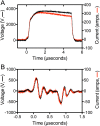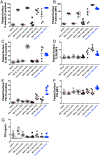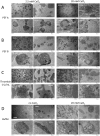Tunable activation of therapeutic platelet-rich plasma by pulse electric field: Differential effects on clot formation, growth factor release, and platelet morphology
- PMID: 30256831
- PMCID: PMC6157860
- DOI: 10.1371/journal.pone.0203557
Tunable activation of therapeutic platelet-rich plasma by pulse electric field: Differential effects on clot formation, growth factor release, and platelet morphology
Abstract
Background: Activation of platelet-rich plasma (PRP) by pulse electric field (PEF) releases growth factors which promote wound healing (e.g., PDGF, VEGF for granulation, EGF for epithelialization).
Aims: To determine after PEF activation of therapeutic PRP: 1) platelet gel strength; 2) profile of released growth factors; 3) alpha- and T-granule release; 4) platelet morphology.
Methods: Concentrated normal donor PRP was activated by 5 μsec (long) monopolar pulse, ~4000 V/cm (PEF A) or 150 nsec (short) bipolar pulse, ~3000 V/cm (PEF B) in the presence of 2.5 mM (low) or 20 mM (high) added CaCl2. Clot formation was evaluated by thromboelastography (TEG). Surface exposure of alpha granule (P-selectin) and T-granule (TLR9 and protein disulfide isomerase [PDI]) markers were assessed by flow cytometry. Factors in supernatants of activated PRP were measured by ELISA. Platelet morphology was evaluated by transmission electron microscopy (TEM).
Results: Time to initial clot formation was shorter with thrombin (<1 min) than with PEF A and B (4.4-8.7 min) but clot strength (elastic modulus, derived from TEG maximum amplitude) was greater with PEF B than with either thrombin or PEF A (p<0.05). Supernatants of PRP activated with PEF A had higher EGF levels than supernatants from all other conditions. In contrast, levels of PF4, PDGF, and VEGF in supernatants were not significantly different after PEF A, PEF B, and thrombin activation. T-granule markers (TLR9 and PDI) were higher after thrombin than after PEF A or B with low or high CaCl2. By TEM, platelets in PEF-treated samples retained a subset of granules suggesting regulated granule release.
Conclusion: Pulse length and polarity can be modulated to produce therapeutic platelet gels as strong or stronger than those produced by thrombin, and this is tunable to produce growth factor profiles enhanced in specific factors important for different stages of wound healing.
Conflict of interest statement
I have read the journal’s policy and the authors of this manuscript have the following competing interests: A.L. Frelinger and A.D. Michelson received research support from GE Healthcare. A. Caiafa, and V. Neculaes are employees of GE Healthcare. A.S. Torres is a former employee of GE Healthcare. This does not alter the authors’ adherence to PLOS ONE policies on sharing data and materials. The remaining authors declare no competing interests.
Figures







Similar articles
-
Modification of Pulsed Electric Field Conditions Results in Distinct Activation Profiles of Platelet-Rich Plasma.PLoS One. 2016 Aug 24;11(8):e0160933. doi: 10.1371/journal.pone.0160933. eCollection 2016. PLoS One. 2016. PMID: 27556645 Free PMC article.
-
Platelet-rich plasma stimulated by pulse electric fields: Platelet activation, procoagulant markers, growth factor release and cell proliferation.Platelets. 2016;27(2):128-35. doi: 10.3109/09537104.2015.1048214. Epub 2015 Jun 1. Platelets. 2016. PMID: 26030682
-
[Experimental research on the effects of different activators on the formation of platelet-rich gel and the release of bioactive substances in human platelet-rich plasma].Zhonghua Shao Shang Za Zhi. 2017 Jan 20;33(1):12-17. doi: 10.3760/cma.j.issn.1009-2587.2017.01.004. Zhonghua Shao Shang Za Zhi. 2017. PMID: 28103989 Chinese.
-
Platelet-rich preparations to improve healing. Part II: platelet activation and enrichment, leukocyte inclusion, and other selection criteria.J Oral Implantol. 2014 Aug;40(4):511-21. doi: 10.1563/AAID-JOI-D-12-00106. J Oral Implantol. 2014. PMID: 25106017 Review.
-
[Research advance on application of platelet-rich plasma in wound repair -- review].Zhongguo Shi Yan Xue Ye Xue Za Zhi. 2009 Jun;17(3):840-3. Zhongguo Shi Yan Xue Ye Xue Za Zhi. 2009. PMID: 19549420 Review. Chinese.
Cited by
-
Harmony in Healing: Investigating Platelet-Rich Plasma Activation during Acetylsalicylic Acid Treatment.Int J Mol Sci. 2024 Oct 14;25(20):11037. doi: 10.3390/ijms252011037. Int J Mol Sci. 2024. PMID: 39456821 Free PMC article.
-
Activation of platelet-rich plasma by pulse electric fields: Voltage, pulse width and calcium concentration can be used to control and tune the release of growth factors, serotonin and hemoglobin.PLoS One. 2021 Apr 23;16(4):e0249209. doi: 10.1371/journal.pone.0249209. eCollection 2021. PLoS One. 2021. PMID: 33891598 Free PMC article.
-
Platelet-Rich Plasma for the Treatment of Tissue Infection: Preparation and Clinical Evaluation.Tissue Eng Part B Rev. 2019 Jun;25(3):225-236. doi: 10.1089/ten.TEB.2018.0309. Epub 2019 May 15. Tissue Eng Part B Rev. 2019. PMID: 30712506 Free PMC article. Review.
-
The Provocative Roles of Platelets in Liver Disease and Cancer.Front Oncol. 2021 Jul 21;11:643815. doi: 10.3389/fonc.2021.643815. eCollection 2021. Front Oncol. 2021. PMID: 34367949 Free PMC article. Review.
References
-
- Klement GL, Shai S, Varon D (2013) The role of platelets in angiogenesis In: Michelson AD, editor. Platelets. 3rd ed San Diego: Elsevier/Academic Press; pp. 487–502.
-
- Driver VR, Hanft J, Fylling CP, Beriou JM, Autologel Diabetic Foot Ulcer Study Group (2006) A prospective, randomized, controlled trial of autologous platelet-rich plasma gel for the treatment of diabetic foot ulcers. Ostomy Wound Management 52: 68–74. - PubMed
Publication types
MeSH terms
Substances
LinkOut - more resources
Full Text Sources
Other Literature Sources
Research Materials
Miscellaneous

